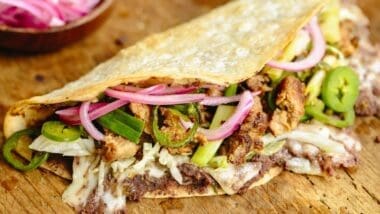A journey through history can be both enlightening and delicious, as demonstrated through the exploration of favorite foods of U.S. presidents. This unique culinary adventure pits Democrats against Republicans in the ultimate test of food preferences, highlighting not just individual tastes, but also revealing subtle insights into the personalities of these historical figures.
George Washington, the nation’s first president and a federalist, was known to relish hoecakes with honey, a simple cornmeal pancake. This delicacy sets the Democratic score at an initial 6.3, described as somewhat dry, yet possessing a likable rustic charm.
John Adams followed with a less conventional favorite: hard cider. Known for being the first to reside in the White House, his choice puzzled many, as a drink seemed an unusual favorite food.
Thomas Jefferson brought mac and cheese to the table, earning a strong Republican favorite. Known for his many achievements, Jefferson’s choice offers a comforting, universally loved dish, reflecting a slight Republican lead with a score of 46.
James Madison, despite being the smallest U.S. president, enjoyed ice cream. His sweet preference continues to score high for the Republicans, revealing his penchant for sweets over savory flavors.
James Monroe, who governed a much less populated America, preferred fried chicken, a choice appreciated for its flavor and crunch. This aligns with a strong showing for the Republicans.
John Quincy Adams, a president with a penchant for photography, loved fresh fruit. His healthy choice offered mixed opinions, sparking a lighthearted debate among testers about its vegetarian appeal.
Andrew Jackson, famous for the cheese block in the White House, favored green beans and bacon, a dish that drew polarized opinions but maintained strong Democratic support.
Martin Van Buren, proudly Dutch, preferred Oysters Rockefeller. His taste for this luxurious dish resonates with Democratic approval, described as creamy yet dominated by its toppings.
William Henry Harrison’s brief presidency revealed a penchant for squirrel stew, substituted with rabbit for modern tastings. Known for his long inaugural speech and tragic fate, his choice reflects a historic, if not adventurous palate.
John Tyler liked Indian pudding, a dish rich with spices, cinnamon, and nutmeg. His large family and affinity for such a dessert reflect a lively life both personally and politically.
James Polk favored cornbread, known for beginning his education late in life, his choice suits those seeking simplicity.
Zachary Taylor’s love for southern-style rice fritters presented a nostalgic, albeit heavy, deep-fried option.
Millard Fillmore, the successor to Taylor, enjoyed beef stew, a hearty choice linking with family gatherings and traditional comfort food.
Franklin Pierce’s fried clams evoked summer memories yet split opinions on its appeal.
James Buchanan preferred sauerkraut during his presidency, attempting political reconciliation yet failing, much like the poor reception of his favorite dish.
Abraham Lincoln, lauded for leadership, preferred bacon, reflecting his strength and popularity. A historical giant, his choice is quintessentially American, adored by many.
Andrew Johnson, a self-taught leader, enjoyed popcorn, a simple yet versatile snack.
Ulysses S. Grant, under whom the telephone era began, loved rice pudding, a dessert praised for its sweet, creamy texture.
Rutherford B. Hayes continued the tradition with cornmeal pancakes, echoing Washington’s tastes.
James Garfield’s preference for squirrel stew mirrored Harrison’s, reintroducing traditional flavors with a score reflecting familiarity.
Chester Arthur, the stylish president, chose mutton chops, a rich, flavorful meat.
Grover Cleveland, with pickled herring as his choice, revealed a complex palate that resonated with his time’s political complexities.
Benjamin Harrison’s fondness for corn with butter and salt reflected a simple yet beloved American classic.
William McKinley favored eggs, versatile, yet plain, appealing to those who appreciate minimalism.
Teddy Roosevelt, known for vigor and adventure, adored steak with gravy, aligning with his robust persona.
William Taft, known for size, also favored steak but paired with potatoes, a classic combi, aligning with his hearty frame.
Woodrow Wilson’s chicken salad preference offered a lighter touch amid wartime duties.
Warren Harding’s chicken pot pie, although poorly executed in testing, remains a comfort food staple.
Calvin Coolidge, enjoying apple pie, aligns with American tradition, despite a mix-up with cherry pie in testing.
Herbert Hoover, fluent in Chinese, preferred sweet potato casserole with marshmallows, a favored Thanksgiving staple.
Franklin D. Roosevelt, known for leadership through conflict, enjoyed grilled cheese, offering comfort amidst adversity.
Harry Truman’s choice of a well-done steak sparked controversy, reflecting his decisive yet divisive style.
Dwight Eisenhower, a leader in war, enjoyed fudge with nuts and marshmallows, a rich, indulgent dessert.
John F. Kennedy cherished clam chowder, a reflection of his East Coast roots.
Lyndon B. Johnson embraced chicken-fried steak, a hearty, Southern staple.
Richard Nixon’s unusual mix of cottage cheese and ketchup marked an avant-garde taste that mirrored his contentious presidency.
Gerald Ford’s pot roast choice highlighted Midwestern roots, aligning with strength and simplicity.
Jimmy Carter’s favored grits were less appreciated, highlighting a regional divide.
Ronald Reagan’s jelly beans reflected the colorful, dynamic era of his presidency.
George H.W. Bush, favoring pork rinds, presented a robust, crunchy snack option.
Bill Clinton’s chicken enchiladas, despite personal scandal, illuminate a preference for bold flavors.
George W. Bush merged loves with cheeseburger pizza, delighting many through combining popular dishes.
Barack Obama, with broccoli as his favorite, drew laughs yet suggested an interest in health.
Donald Trump, known for straightforwardness, favored fast food like KFC, showcasing a populist taste.
Current president Joe Biden favors ice cream, specifically chocolate chocolate chip, as a sweet finale to this historical taste test.
This culinary exploration of presidential preferences reveals not just the differing tastes of America’s leaders, but also opens a window into the history and culture that shaped them. From humble cornbread to luxurious Oysters Rockefeller, these choices highlight diverse backgrounds and personal stories, symbolizing the melting pot that is the United States. While Republicans claimed victory in this particular taste test, the journey through America’s culinary past remains a fascinating topic for history and food enthusiasts alike.
Source: Youtube














